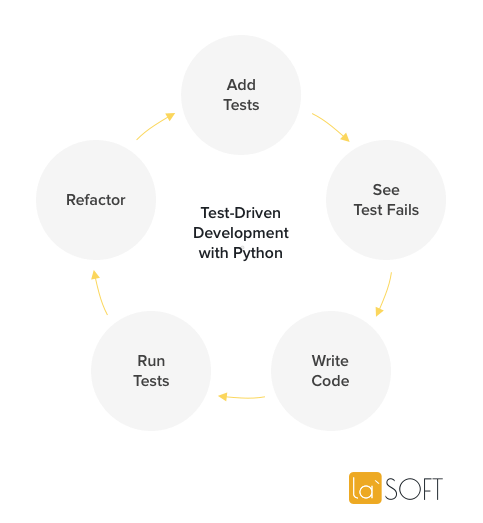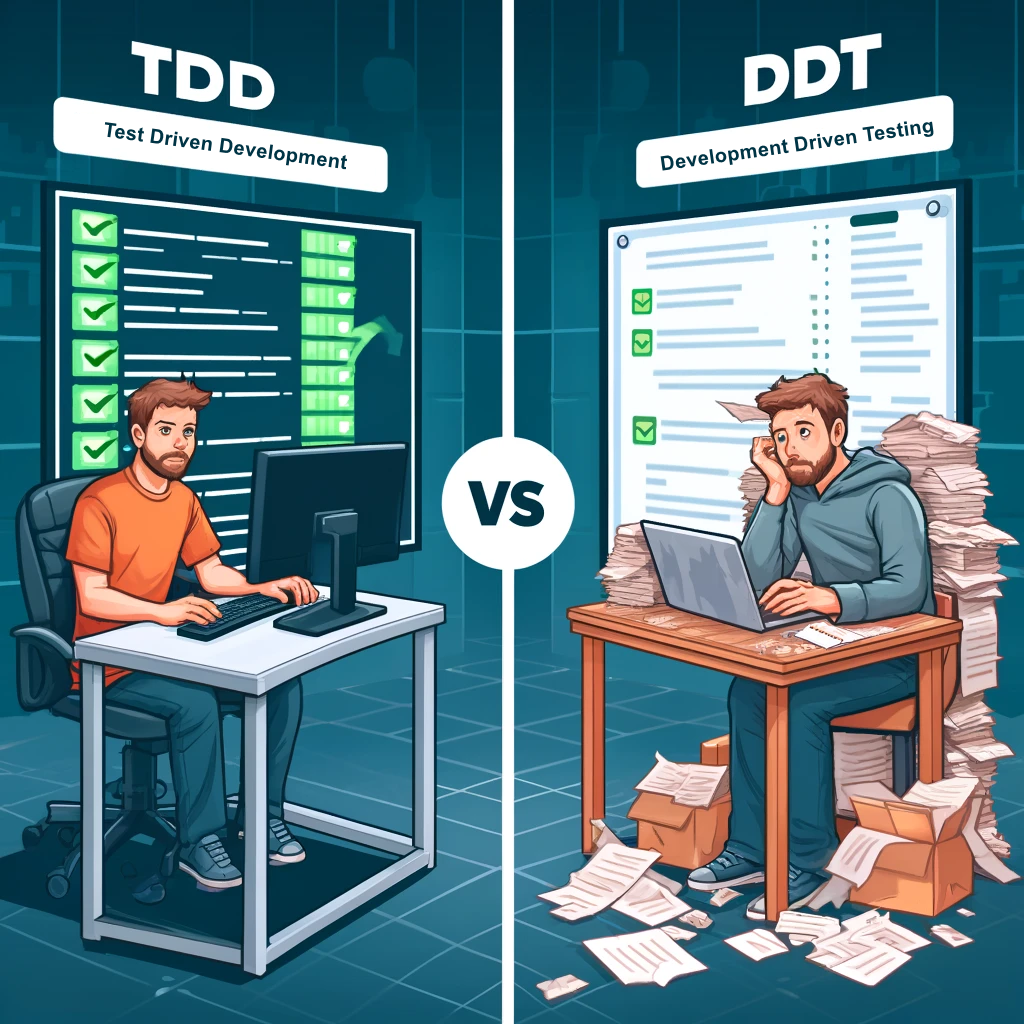Test Driven Development (TDD) is a software development process in which a developer writes test of their code before writing the code itself. The test-first concept encourages repetition of very short development cycles with the writing of just enough code to pass the test.
All code is guilty until proven innocent
The main idea of the approach is to catch all bugs before they can make any harm to the program in development. It gives the developer an extra space to think about what they are implementing before they actually start implementing it. The divine mantra of Test Driven Development is “red/green/refactor”, where red means fail and green means pass.
Test Driven Development lifecycle
TDD was originated by software engineer Kent Beck, who described TDD lifecycle in his book “Test Driven Development: By Example”:
- Add a test
- Run all tests and see if the new test fails
- Write the code
- Run tests
- Refactor code
- Repeat

Pros and Cons of Test Driven Development
These lists present a balanced view of TDD, highlighting both its strengths in improving code quality and potential drawbacks in terms of complexity and resource demands.
TDD pros:
- Comprehensive test coverage – all written code is covered by at least one test
- The greater level of confidence in the code
- Well-documented code
- Understanding the requirements before writing the code
- Continuous integration
- Increased productivity
- Reinforced mental model of the code
- Focus on design, interface, and functionality of the program
- No need in tedious debugging
- More stable system
Still, Test Driven Development has several cons:
- More code is required with TDD than without TDD
- False sense of security due to a large number of tests
- Maintenance overheads
- Additional time for an excessive number of tests
- Requires to know how to set up and use a testing environment
- Takes time and efforts to become proficient in TDD
- Too much TDD makes the code more complicated than necessary
- Discourages big picture design
- Higher cost
Table: Pros and cons of Test Driven Development (TDD)
| Advantages of TDD | Challenges of TDD |
|---|---|
| Complete Test Coverage: Every piece of code is tested, ensuring thorough validation. | Increased Code Volume: TDD often requires writing more code than non-TDD approaches. |
| High Confidence in Code: The rigorous testing provides a strong assurance of code reliability. | Potential Overconfidence: The abundance of tests might lead to a false sense of security. |
| Well-documented Code: Code is inherently documented through tests, clarifying what each part should do. | Maintenance Overhead: Tests themselves need maintenance, adding to the workload. |
| Pre-implementation Requirement Clarity: Ensures a clear understanding of requirements before coding begins. | Time Intensive: Managing an excessive number of tests can significantly increase development time. |
| Seamless Integration: Continuous integration is facilitated, catching issues early and often. | Setup Complexity: Requires proficiency in setting up and maintaining a testing environment. |
| Boost in Productivity: Streamlined workflows and early error detection often lead to increased efficiency. | Learning Curve: It takes significant effort and time to master TDD practices. |
| Reinforced Understanding of Code: Developers maintain a strong mental model of the code structure and behavior. | Code Complexity: Excessive TDD might lead to unnecessarily complicated code structures. |
| Design and Functionality Focus: Encourages a focus on the design and usability of the software from the start. | Design Limitations: May inhibit big-picture architectural thinking and holistic design approaches. |
| Reduced Debugging Time: Minimizes the need for debugging by catching issues at the testing phase. | Increased Costs: The comprehensive approach of TDD can lead to higher initial costs. |
| System Stability: Results in a more reliable and robust system due to early defect detection. | Adaptability Challenges: Frequent changes in project requirements can complicate TDD processes, requiring significant adjustments to tests and potentially leading to delays. |
The Advantages of Test Driven Development in Leading Tech Companies
Numerous leading technology companies prioritize the Test Driven Development approach due to its significant benefits in enhancing code quality and operational efficiency. Esteemed organizations such as Google, Facebook, Spotify, Etsy, and Buffer have adopted TDD, recognizing its potential to bolster accuracy and productivity. TDD not only instills a higher degree of confidence in the code but also facilitates the creation of clear roadmaps and logical pathways during product development. Furthermore, this methodology encourages the development of code that is highly modular, making it easier to extend and adapt over time, thus supporting continuous innovation and improvement. This strategic adoption by major industry players underscores the value of TDD in maintaining competitive edge and fostering technological advancements.
The Ruby on Rails Community and TDD
The Ruby on Rails community is renowned for its uncompromising commitment to code quality, treating Test Driven Development as an integral part of its coding standards. While TDD might initially appear counterintuitive, it is highly valued for its ability to ensure high-quality code and extensive test coverage. By embracing TDD, developers can create code that is not only better structured and easier to understand but also significantly simpler. This methodology plays a crucial role in reducing the occurrence of unnoticed bugs, thereby enhancing the overall robustness and reliability of applications. The Ruby on Rails community’s endorsement of TDD highlights its effectiveness in building maintainable and error-resistant software.
Comparison of Software Development Process Types
Test Driven Development holds a unique position among software development methodologies due to its specific focus on the use of automated unit tests to guide the design and development of software. Unlike traditional methodologies such as Waterfall, which is linear and sequential, or Agile, which emphasizes flexibility and iterative progress, TDD is primarily concerned with ensuring that coding, testing, and design are tightly integrated.
| Feature | Waterfall | Agile | Test-Driven Development (TDD) |
|---|---|---|---|
| Approach | Sequential design process | Iterative and incremental process | Test-first development process |
| Flexibility | Low flexibility; changes are difficult and expensive | High flexibility; adapts to changes rapidly | Moderate flexibility; changes are incorporated through ongoing testing |
| Testing | Conducted after the development phase | Continuous throughout the development cycle | Integral part of the development, tests are written before code |
| Documentation | Heavy emphasis on documentation | Less emphasis, prioritizes working software | Documentation through test cases |
| Feedback Loop | Long feedback loops, mostly during testing phase | Short feedback loops, continuous feedback through iterations | Continuous feedback via failing and passing tests |
| Project Size Suitability | Better suited for small to medium-sized projects with well-defined requirements | Suitable for projects of various sizes, especially where requirements are expected to change | Best suited for projects where code robustness and quality are critical |
| Risk Management | Risks identified and addressed during specific phases | Risks are managed continuously and iteratively | Risks in code functionality are identified and mitigated early |
This table provides a comprehensive comparison of three predominant software development methodologies: Waterfall, Agile, and Test-Driven Development (TDD). It outlines the fundamental characteristics, workflow, benefits, and challenges associated with each method to help stakeholders make informed decisions about which approach best suits their project requirements.



